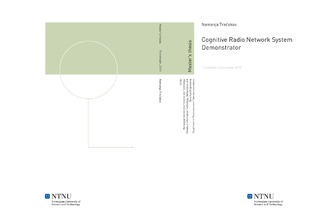| dc.description.abstract | The frequency spectrum is presently poorly utilized and lies idle for the most of the time. In order to utilize the spectrum more efficiently, Dynamic Spectrum Access (DSA) should be used. A common approach to this thought is hierarchical DSA, where the license-paying, or the primary users, have the priority in using and accessing the network. The rest of the potential users, or the secondary ones, are accessing and using the resource in an opportunistic manner, ?borrowing? it as long as the resource is sensed as idle. This kind of resource access implies the use of cognitive techniques for spectrum sensing in order to discover the available resources and avoid collisions. However, exactly these two are the main issues regarding the cognitive networks: sensing method and interference control.
Many theoretical studies indicate the increase in efficiency with use of DSA. However, the few successfully performed experiments which evaluated the real performance have been carried out with expensive and complex-to-use radio platforms, or those employing low bandwidth resulting in low throughput.
In this document, a proposal for a cognitive radio network system demonstrator is described in detail. The demonstrator is based on IEEE802.11g standard employing OFDM, and is supposed to be carried out with use of 9 highly flexible USRP2 software defined radio (SDR) platforms and its complementary GNU Radio software.
The goal with the demonstrator is to show that the introduction of the secondary user in the network will introduce no or negligible degradation to the primary network.
A common problem regarding SDR platforms is the latency, introduced due to the fact that the vast of signal processing is performed in the host processor. To address this issue, the split-function architecture is chosen to be used, implementing the most time-critical functions in the FPGA on the platform.
The projects resulted in the full description of the demonstrator for the cognitive radio, but unfortunately without the implementation of the same due to the complexity of the work and limited amount of time. However, the project resulted in a set of advices and manuals providing the building stones on the way to the goal of implementing the cognitive radio on the USRP2. | |

